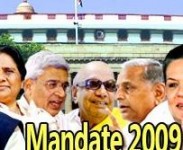24X7 overdose

Second Take
Kalpana Sharma
Now that this prolonged election process is over, it is time to reflect on how the media handled it. It was a difficult election to cover because it never seemed to end. But the worse period was the three days after the end of the last phase and May 16, when the votes were counted. Print as usual had the advantage of waiting and watching. But the electronic media, having to feed a 24-hour news machine had no such luxury. It had to keep inventing and re-inventing subjects that could be discussed, exit polls that could be analysed at the risk of going completely wrong, and endless speculation about the future, including calculations about alignments between different parties and possible scenarios that left the poor viewer in a daze.
None of this prepared anyone for the surprise package delivered on May 16. Both NDTV and CNN-IBN claimed they had already predicted the outcome. That was stretching it a little bit. But they did come much closer to the reality. And at a time when pollsters had taken a beating after they went so wrong in 2004, I suppose they could be forgiven for being so self-congratulatory. As they were, repeatedly.
In those three days before the counting, one wondered whether we should have 24-hour news channels. This is something several commentators have questioned. News on the hour, except when there is something exceptional – such as a terror attack, or elections – is probably as much information as anyone can digest. The BBC and CNN are 24-hour news channels. But their bulletins are interspersed with features, documentaries etc. But the relentless flow of news and opinions, day and night, of the kind we get in
In this election, in the absence of exit polls except at the very end, this became even more evident. How do you discuss an election if you cannot put out any information about the possible trend in voting? One solution is not to discuss it but to report what people are thinking and saying, the issues that they consider important, the development or lack of development in so many parts of the country etc. There are a hundred more imaginative ways of dealing with elections than having talking heads in a studio.
Even if you have studio discussions, they can engage in issues apart from poll arithmetic. NDTV, for instance, had a programme anchored by Prannoy Roy where Jean Dreze and P. Sainath were asked to comment on what they felt were the "real issues" during these elections. As a result you heard words like "hunger", "livelihood", "debt", "deprivation" and also about the National Rural Employment Guarantee Programme that is now being credited with the good showing of the Congress, or Sarva Shiksha Abhiyan and other developmental programmes. But the programme was an aberration. No sooner had it ended than the discussion reverted to the usual mix of political calculations and personalities.
It is also fascinating to note, in these recessionary times, how commercial compulsions dictate the choice of panelists in some of these channels. NDTV, for instance, had a programme called "Editors’ Verdict" every night at
A similar effort to give a lighter and perhaps more frivolous touch to election analysis could possibly have dictated the tone of the discussions on NDTV on May 16. Even the set looked like a special dining room in a five-star hotel. The chatter was always as if between friends. Everyone was on first name terms. There were "in" jokes. This was the club of people who believe they have the power to make policy. How else would you explain them seriously discussing who should get which ministry even as the Congress Party spokespersons politely and repeatedly stated that the choice was in the hands of the Prime Minister?
CNN-IBN was a little less "clubby" and had a better balance on its panel – barring the fact that it was an all male panel most of the time. Yogendra Yadav was a particularly important asset as he backed his opinion with data. Yet, the old boys club was much in evidence as the ever ebullient Rajdeep Sardesai enthusiastically told Jammu and Kashmir Chief Minister Omar Abdullah that he wanted to come to
Both NDTV and CNN-IBN seemed to forget that there were women journalists covering politics who were also available to comment and analyse. Both channels have women anchors who are themselves experienced political journalists. But barring them, there were hardly any women on the panel in the run up to counting day. On May 16, we were treated to a line up of men, barring Jayanti Natarajan of the Congress Party who flitted from channel to channel.
Times Now was the only
At the end of this really long month, many viewers will probably be glad to get back to watching serials and sports and occasionally turning to the news. If ever there was a case of serious overdose, this was it.






